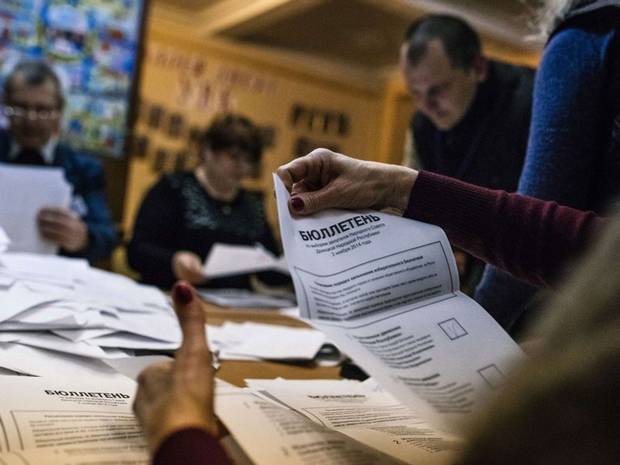
Donetsk, Luhansk ‘People’s Republics’ Stage Elections in Ukraine’s Donbas
Publication: Eurasia Daily Monitor Volume: 11 Issue: 197
By:

On November 2, the Russian-controlled Donetsk and Luhansk “people’s republics” (“DPR, LPR”) in Ukraine’s Donbas (eastern region encompassing the Donetsk and Luhansk provinces) staged “presidential” and “legislative” elections for the first time. These were conducted in the presence of Russian and proxy troops on what is legally Ukraine’s territory.
The incumbent “DPR prime minister,” Aleksandr Zakharchenko, has been elected as “head [glava] of the republic” with some 78 percent of the votes purportedly cast (“glava” replicates the title of top leaders of constituent republics of the Russian Federation). Two other candidates also ran. The recently improvised political groups, Donetsk Republic (led by Zakharchenko) and Free Donbas, gained 68 percent and 32 percent, respectively, of the votes purportedly cast in electing a “DPR” People’s Council (would-be legislature) (drn.today, November 3, 4).
“LPR’s” incumbent “head” (glava) by appointment, Igor Plotnitsky, has now been elected to that post with 63 percent of the votes purportedly cast. Three other candidates also ran. Two hitherto unknown groups, Peace to Luhansk (Plotnitsky’s political base) and the Luhansk Economic Union, gained 69 percent and 22 percent, respectively, of the votes purportedly cast in electing an “LPR” People’s Council (lugansk-online.info, November 3, 4).
Both “republics” have claimed a high voter turnout, but neither gave conclusive turnout figures. The process was chaotic, relatively few polling stations were open, many inhabitants could not or would not cast ballots, while those who did were able to do so multiple times. Paramilitary fighters from Russia currently residing in Donbas were eligible to vote; while internally displaced persons from Donbas currently residing in Ukraine’s interior could cast ballots (OstroV, Novosti Donbassa, November 2–4).
These elections are not recognized internationally and were not monitored. However, these elections saw the largest-ever deployment of the “Putintern” (“Putin International,” an allusion to the erstwhile “Comintern”—Communist International). Approximately sixty representatives of European radical-right and radical-left groups—cumulatively: the “Putintern”—were on hand to observe the DPR and LPR elections and pronounce them free and clean. This ideological Putintern collects some non-ideological European fellow-travellers, in the shape of regional identity-based groups with centrifugal agendas. These look for precedent-setting cases of territorial secession, as in Crimea in April and in Donbas now. Russian state television showcased these observers’ laudative assessments of the elections.
Zakharchenko, born in Donetsk province in 1976, a trained electrician, left his job in the coal mines in 2011 to become the Donetsk branch manager of the Kharkiv-based Oplot fight club. He was active in the pro-Russia armed rebellion in Donetsk from the outset in April 2014, led an Oplot paramilitary unit under Colonel Igor Girkin/Strelkov’s command, received a symbolic rank of major from Strelkov, but disagreed with him eventually over defense tactics. When Moscow decided to recall Strelkov and “DPR prime minister” Aleksandr Boroday from Donetsk in early August, Moscow looked for a tried and tested native replacement with an unmistakably Ukrainian surname. In the second week of August it appointed Zakharchenko as “DPR prime minister,” very briefly under Boroday’s informal tutelage.
Plotnitsky, born in 1964, presumably in Luhansk (unconfirmed), was a small-time dealer in fuel and lubricants there during the 1990s, later a consumer rights inspector for the Luhansk province administration, and “LPR defense minister” in May 2014, awarded with the rank of major. In the second week of August (when Moscow also changed the guard in Donetsk), Plotnitsky replaced Valery Bolotov as “head” (glava) of the “LPR.” Plotnitsky and Zakharchenko signed the two armistice agreements in September on behalf of the respective “people’s republics.”
Both “republics” are internally chaotic, with multiple political factions and armed groups operating autonomously, and dividing or disputing turf among themselves. While the “DPR” can point at least to some rudiments of institutions, the “LPR” is even less institutionalized, experiencing sheer anarchy. Their handlers in Moscow undoubtedly count on these elections to stabilize and institutionalize the two “republics’” internally. Moscow also grooms them for equal status with Kyiv in international negotiations on conflict-resolution, even in the absence of a legal status.
The military demarcation line, supposedly agreed in the September armistice agreements, would partition Ukraine’s Donetsk and Luhansk provinces. The “DPR-LPR” control somewhat more than one half of the combined population (primarily the urban agglomerations). Ukraine controls somewhat more than one half of the combined land area (mainly the countryside). However, the demarcation line is not conclusively agreed since Moscow and its proxies seek corrections (see EDM, October 9, 10).
The “DPR” and “LPR” election winners laid claim to the entire territory of Ukraine’s Donetsk and Luhansk provinces during the electoral campaign just concluded. Whether these claims amount to electoral posturing, or reflect the leaders’ post-election intentions, remains to be seen. The decision will be Moscow’s, not theirs.




